How can any amp running a pair of 6L6GCs be 60 watts? Other Fenders running 6L6GC's are rated at 40 watts, and I thought even that was a little ambitious?
Announcement
Collapse
No announcement yet.
Fender Vibro King rated at 60 watts?
Collapse
X
-
Always take those power ratings with "a grain of salt". Most are instantaneous peak power or someother mathematical construction, not "real" power.
http://tdsl.duncanamps.com/show.php?des=6L6GC
Data Sheet values are 47W at B+ of 360V and 55W with B+ of 450V in Class AB1.
It is concievable that they might get 60W in Class AB2 and high B+ but would require cathode follower drivers of the output tube grids and seriously degraded reliability and logevity of output tubes.
Not sure about 6L6GC but with EL34 I alway found them to be stunning at B+ of around 380V giving a 32W (continuous sine wave at just below clipping) rather than hammering them with High B+ just to get another 10 to 15 Watts.
Cheers,
Ian
-
IF the B+ is high enough, the power supply stiff enough, and the OT ratio near exact to the load, you can approach 60W. More likely Fender is quoting the power figure well into the clipping range, with an unspecified distortion component, say 10 or 20%. FWIW, without a handy distortion meter, I measure amps just below the clipping point, into a resistor at the amp's rated load. IIRC most of the time Vibro Kings come in at about 45 to 48 watts. LG's rule of thumb for power with respect to distortion: for every 5% increase in distortion you can count about a 12% increase in power. So if Fender is measuring at 10% distortion you can see how they can quote 60 watts.This isn't the future I signed up for.
Comment
-
Fender output power is stated at 5% THD...just check the schematics.
Also, using Ultra-Linear OT gets 2x6L6GC up to 60W, something CBS/Fender did alot.Last edited by Old Tele man; 12-18-2018, 12:45 AM....and the Devil said: "...yes, but it's a DRY heat!"
Comment
-
Imagine a guitar amp, it is a crappy design, though put together well of good materials. No matter what it will NOT produce a distortion free output from its pair of 6L6s. Oh maybe half a watt clean. Now what does this amp put out? Half a watt? If we connect the amp to a one watt speaker, does that mean our half watt amp won;t hurt it? Or will the 50 watts of loud SOMETHING that comes out burn it to a crisp? I think the latter. SO if you need to choose a speaker to handle this amp, will you be looking for some hifi, distortionless specs? Or will you want to know how much sound signal it can crank into a speaker, regardless of distortion?Education is what you're left with after you have forgotten what you have learned.
Comment
-
I wasn't sure where you were going with this at first, but you make an great point.Originally posted by Enzo View PostImagine a guitar amp, it is a crappy design, though put together well of good materials. No matter what it will NOT produce a distortion free output from its pair of 6L6s. Oh maybe half a watt clean. Now what does this amp put out? Half a watt? If we connect the amp to a one watt speaker, does that mean our half watt amp won;t hurt it? Or will the 50 watts of loud SOMETHING that comes out burn it to a crisp? I think the latter. SO if you need to choose a speaker to handle this amp, will you be looking for some hifi, distortionless specs? Or will you want to know how much sound signal it can crank into a speaker, regardless of distortion?
For measuring output power in audio, the general orthodoxy could be simplified as measuring the voltage of a sine wave output (usually 1kHz) into a resistive load, just before the point of clipping. Then take the (RMS) V2/Ω as the max output power rating– Correct? (I know that manufacturers often list several output specs into different load impedance, and usually provide a the of % of distortion as well)
To your point Enzo, most commercial stereo/PA/hifi operation will not push the amp into overdrive, so the output power can be an accurate and useful specification. Guitar amps are often designed for and operated well past the point of clipping and heavily over-driven. In this case the output voltage has a closer resemblance to a square wave vs a sine wave, and power can be quite a bit higher.
For guitar amps, the industry standard measure of audio output power seems inappropriate, or inaccurate in many instances. I was wondering if any manufacturers make accommodations for this, or list "clean" output and full output?If I have a 50% chance of guessing the right answer, I guess wrong 80% of the time.
Comment
-
For durability a Guitar amp speaker must be able to stand the RMS output of a quite clipped power amplifier, because these amps are usually used full blast, devil-may-care about waveform.
And a squarewave has up to twice as much RMS (thermal) power as maximum signal which can be pulled out of same amp.
Speaker does not know about waveform, voice coil DC resistance turns input voltage and current into heat, so if an amp has, say, 60W RMS "just clipping but still looking quite the sinewave" , it may easily have 90 or 100W RMS squarewave.
3 mitigating factors in this nightmarish situation:
1) "musical" output from a guitar is not as continuous as that from an oscillator, or it would be very boring and musically useless, it will never be 100" continuous duty, a feedback sustained squarewave never lasts for an hour ... or 15 minutes ... or even 5 minutes.
Even Santanaīs endless sustain "signature" lasts no more than a few seconds,definitely less than a minute each time.
Too sleepy now but ..... any volunteers to clock them?
2) typical tube output waveform is not a perfect , symmetrical, 100% duty cycle squarewave, even if driven balls to the wall.
What heats voice coils up is "the area under the curve" .
perfect squarewave has maximum heating effect because it has maximum surface under it, by definition, reaching 200% of maximum clean power.
ANY deviation from that means less than 200%.
These are typical scoped (as opposed to "hand drawn" he he) overdriven amp waveforms:

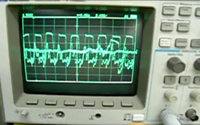

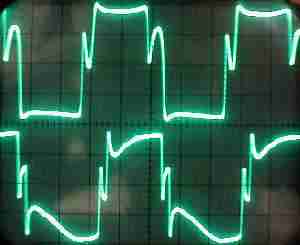
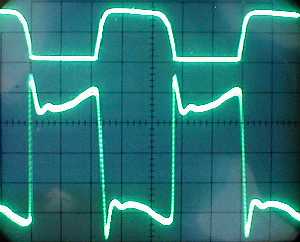
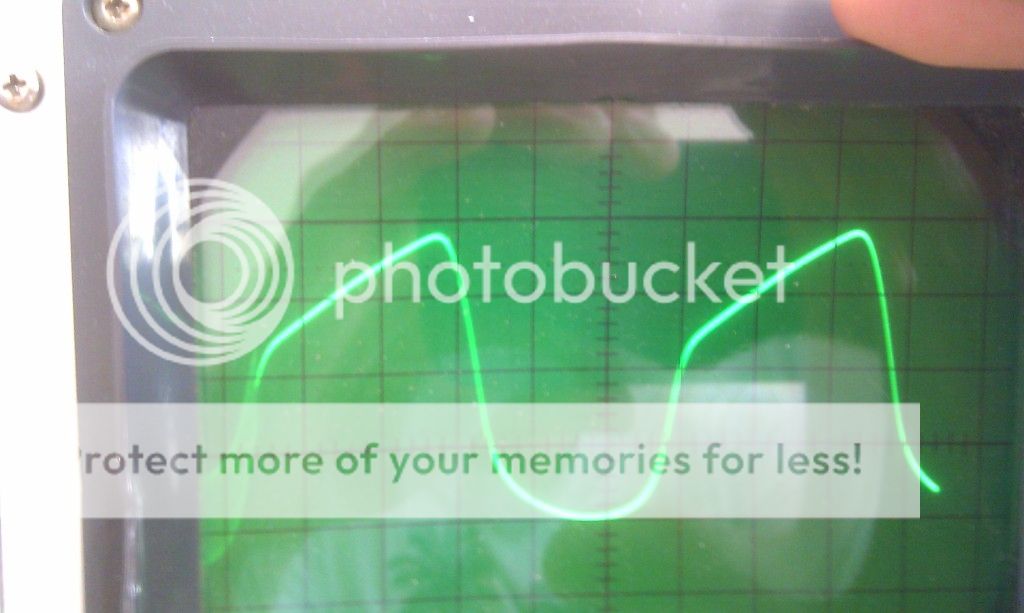
Now, SS amplifiers are **deadly**
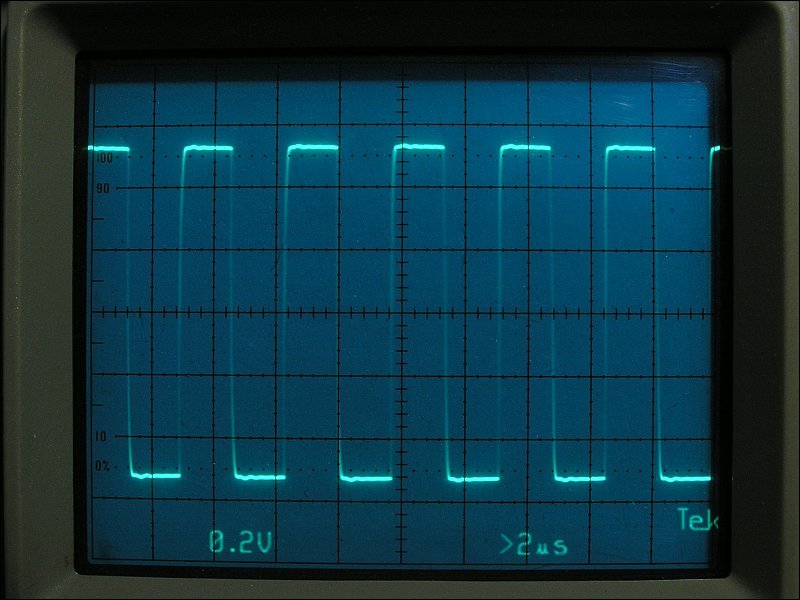 Last edited by J M Fahey; 12-19-2018, 10:41 AM.Juan Manuel Fahey
Last edited by J M Fahey; 12-19-2018, 10:41 AM.Juan Manuel Fahey
Comment
-
Run out of image space.
3) and many ignore a "self protection" mechnism built into speakers: the hotter the voice coil becomes, the higher DC resistance it has, that limits absorbed power, basic Ohmīs Law.
Say a speaker is nominally 8 ohm, has "cold" DC resistance of, say, 6.5 ohm , and imopedance only reaches that low at some frequency between 200 and 400Hz; at any other frequency impedance is higher.
And such higher impedance is reactive, not resistive, so in theory "does not dissipate heat", so we must worry only about DC resistance .
Say we have an SS amplifier (the worst offenders) rated 50W RMS into an 8 ohm speaker.
That means 50W RMS.
Which "thermally" means somewhat less than 50W RMS ... some of that power fed to it actually drives air producing sound.
And outside that impedance dip (between 200 and 400Hz) impedance is higher (up to 30-60 ohm at resonance and 12-16 ohm at high frequencies, from 1kHz up)
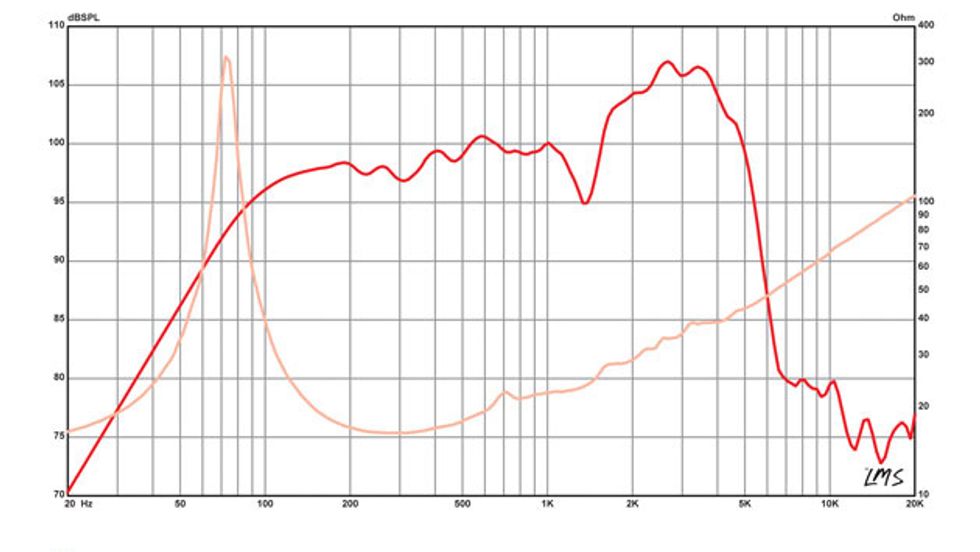
And when heated, DC resistance goes up ... a lot.
So if the speaker had 6.5 ohm DCR "cold" ... it will definitely have quite higher DCR at 50W RMS.
Say itīs risen to 9 ohm DCR.
Now you feed it 28V Audio, mathematically twice as much power as before.
Speaker does not know whether those 28V come from a clean 100W driven *just* to clipping or a 50W amp driven balls to the wall, its voice coil will turn that into heat.
But ... will we have the expected (and voltage measured) 100W RMS?
No way, at the increased drive voice coil DCR will rise to, say, 12 ohm.
So "twice the power" 28V vs. 20V in practice will NOT mean twice the temperature rise, no way, but rather , say, 70% more.
Also higher power means more voice coil movement back and forth, which contributes to cool it .
I have tested voice coils "alone" , sitting on a brick: ones known to stand 100W RMS inside a speaker and doing their job safely, toasted with as low as 30 or 40W RMS, and exploded into smoke and flames if fed 100W RMS continous tone.
Easy: no moveent, no heavy magnet structure 0.15mm on each side to pull heat out.
Thatīs also why basically same wound on paper voice coil stands 20/25W RMS inside a Greenback and 30W RMS inside a G12H: way stronger magnet and heavier magnet structure (155 mm diameter vs. 140/145mm) means more movement and heavier heatsink for the G12HJuan Manuel Fahey
Comment
-
As an exampleOriginally posted by SoulFetish View Post...For guitar amps, the industry standard measure of audio output power seems inappropriate, or inaccurate in many instances. I was wondering if any manufacturers make accommodations for this, or list "clean" output and full output?
My band:- http://www.youtube.com/user/RedwingBand
Comment
-
I remember those old and bragging Marshall specs, always found them quite optimistic,.
Never ever could replicate them.
>100W RMS on 4 bottle amps?: *only* when using "super" tubes such as 6550/7027/KT88 and maybe the odd KT66
But on most 100W amps using way more current 6L6/EL34 ? ... very unlikely.Juan Manuel Fahey
Comment
-
-
Yes, I know them, they are (were) very famous in Argentina.
I built many, same as others, because Philips published full winding data for Power and Output transformers, which to boot were *easy* to build, using common iron and wire.
Funny thing is that they only showed a 500 ohm secondary, because it was a "Large amp only suitable for PA in a large place" as in a train station, football club and such.
I was the "madkid" who calculated an 8 ohm secondary and coupled it to 4 x 12" speakers to sell "100W" Guitar and Bass amplifiers, way back then unheard of.
https://www.radiomuseum.org/r/philip...0w_en_kit.html
But it was terrible for Guitar/Bass use: it was biased very cold and sound was choppy and harsh, thatīs why nobody used it for Musical Instruments, thatīs why it canīt be compared to all above.
Of course, the built in "choppy noise gate" effect is an advantage in the PA world Juan Manuel Fahey
Juan Manuel Fahey
Comment
-
My Siemens amp is a little different (Philips and Siemens have always been competitors). It only uses EF40s and EL34s, no tube rectifiers. It puts out almost 100Vrms into a 100 Ohm load before clipping. Might have been designed for a little lower wattage at 220V. Cathode idle current is 25mA. I have not found any documentation yet.
But my actual message was that output mainly depends on plate voltage (and power tube saturation voltage, PS regulation, OT losses). As EL34s allow for higher plate voltage than 6L6s, more output is possible.
BTW, as KT66s typically have higher saturation voltages than 6L6GCs, output will be lower.- Own Opinions Only -
Comment

Comment